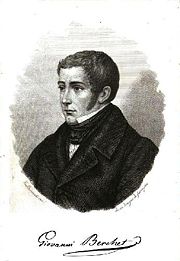
Giovanni Berchet
Encyclopedia

Romanticism
Romanticism was an artistic, literary and intellectual movement that originated in the second half of the 18th century in Europe, and gained strength in reaction to the Industrial Revolution...
, Lettera semiseria di Grisostomo, which appeared in 1816, and contributed to Il Conciliatore
Il Conciliatore
Il Conciliatore was a progressive bi-weekly scientific and literary journal, influential in the early Risorgimento. It was published in Milan from September 1818 until October 1819 when it was closed by the Austrian censors. Its writers included Lodovico di Breme, Giuseppe Nicolini and Silvio...
, a reformist periodical.
Berchet was born in Milan
Milan
Milan is the second-largest city in Italy and the capital city of the region of Lombardy and of the province of Milan. The city proper has a population of about 1.3 million, while its urban area, roughly coinciding with its administrative province and the bordering Province of Monza and Brianza ,...
. He participated in various nationalist activities, including the revolutions that shook the Italian peninsula in 1821. Thereafter, he lived in exile, primarily in Britain
United Kingdom of Great Britain and Ireland
The United Kingdom of Great Britain and Ireland was the formal name of the United Kingdom during the period when what is now the Republic of Ireland formed a part of it....
, until returning to Italy to take part in the revolutions of 1848. His works include Il trovatore, Il romito del Cenisio, and, most famously, I profughi di Parga (1821).
Lettera semiseria (Half-serious letter) presents the translations (written by Berchet) of two poems by Gottfried August Bürger
Gottfried August Bürger
Gottfried August Bürger was a German poet. His ballads were very popular in Germany. His most noted ballad, Lenore, found an audience beyond readers of the German language in an English adaptation and a French translation.-Biography:He was born in Molmerswende , Principality of Halberstadt, where...
as an example of a new kind of poetry, and expresses the author's thought about contents and language that can reach a new public: that is, no longer a public of academic readers, but the so called "third class", i.e. the bourgeoisie, which is waiting for books that are interesting, full of real feelings, simple in language, without mythology
Mythology
The term mythology can refer either to the study of myths, or to a body or collection of myths. As examples, comparative mythology is the study of connections between myths from different cultures, whereas Greek mythology is the body of myths from ancient Greece...
and classic models.
This text took an important part in the debate over Romanticism that developed in Italy (specially in Milan
Milan
Milan is the second-largest city in Italy and the capital city of the region of Lombardy and of the province of Milan. The city proper has a population of about 1.3 million, while its urban area, roughly coinciding with its administrative province and the bordering Province of Monza and Brianza ,...
) in the second decade of the 19th century.

